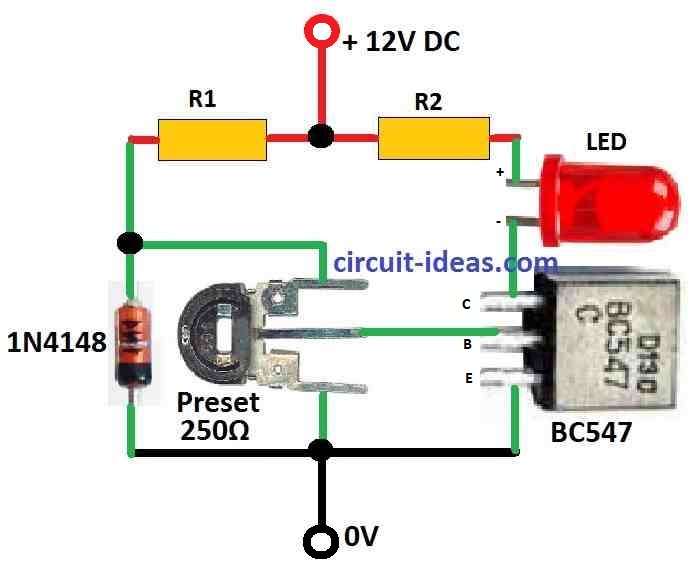To make a Simple Temperature Indicator Circuit using a Single Transistor is not so hard like people think.
This article tell how anyone can build this easy circuit using one diode, one transistor and some other small parts.
What is a Temperature Indicator Circuit using a Single Transistor:
Using one transistor, temperature indicator circuit is easy electronic thing that show temperature change by looking.
Thermistor or other part that change with temperature is mostly used to sense the heat.
This article help anyone to make this circuit step by step with some important formula for good result.
Circuit Working:

Parts List:
| Type | Specification | Quantity |
|---|---|---|
| Resistors | R1 and R2 values as per calculations | 1 each |
| Preset 250Ω | 1 | |
| Semiconductors | Transistor BC547 | 1 |
| Diode 1N4148 | 1 | |
| LEDs red 20mA 5mm | 1 |
Semiconductors like transistor and diode are simple parts that change how they work when temperature goes up or down.
Their behavior is mostly how voltage pass through them and changes when surrounding temperature change.
This circuit use one diode and one transistor in bridge way.
These two parts work together because both react similar to temperature change.
Diode is used as reference part and transistor is used for sensing heat.
It is important to keep diode in place where temperature stays the same.
If diode get heat or cold it can change its level and give wrong result.
One LED is connected to transistors collector.
This LED shows temperature difference with light so we can see how much heat is around transistor.
Diode stays at room temperature and transistor is put near hot thing to measure heat.
Transistors base emitter voltage is checked with diodes voltage.
LED show this difference with more heat and more light.
When transistor get hot its voltage goes up.
When temperature pass the set limit transistor start working and LED glow more as heat increase.
Safety:
Do not let transistor go more than 120°C or it can get damaged forever.
Formula and Calculations:
To find temperature limit we need to calculate resistor values using these formula:
R1 = (Ub − 0.6) / 0.005
R2 = (Ub − 1.5) / 0.015
here,
- Ub is the power supply voltage
- 0.6 is the forward voltage drop of transistor BJT
- 0.005 is the normal current for transistor
- 1.5 is the forward voltage drop of red LED
- 0.015 is the normal current for LED to blink properly
The answer we get is in ohms.
The preset P1 should have value between 15 which is the incomplete information maybe it should be 15k ohms or similar
How to Build:
To build a Simple Temperature Indicator Circuit using a Single Transistor follow the below mentioned connections steps:
- First collect all parts needed.
- Place transistor, diode and LED on breadboard.
- Be sure transistor is connected correct way.
- Join transistor and diode like bridge connection.
- Diode is for reference and transistor is for sensing heat.
- Connect transistors collector pin to LED.
- This LED will show heat change by light.
- To make reference voltage connect diode.
- Keep diode in place where temperature stay same.
- Now connect circuit to preset.
- This help adjust reference voltage.
- Be sure transistor does not get hotter than 120°C or it can break.
- If needed we can change circuit to control outside device when temperature changes.
Testing:
- Switch ON the circuit and look at LED.
- When temperature goes above the set limit LED will glow more bright to show the heat level.
Conclusion:
By following these above steps anyone can make an easy and useful Simple Temperature Indicator Circuit using a Single Transistor and one diode.
Do not forget to follow safety warnings.
Also think about changing things if needed to make circuit work better as explained in this article.
Leave a Reply